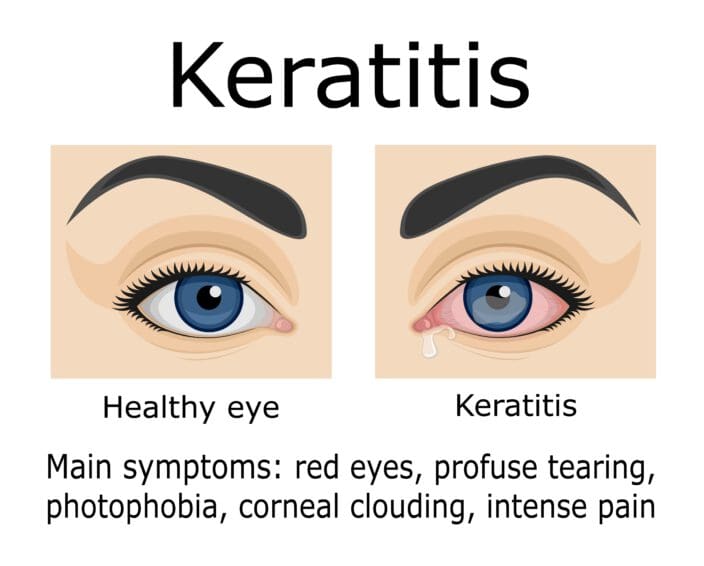What to Know About Keratitis: Dangers, Symptoms, Treatment
Home / Eye Conditions & Eye Diseases /
Last Updated:
Keratitis is a condition where the cornea becomes inflamed or swollen. This can affect vision, cause pain, make it difficult to open the eye, and trigger other issues.
Keratitis can get worse with time, potentially causing blindness if left untreated. If you suspect you have keratitis, you should get help as soon as possible.
Keratitis can come from a variety of sources. The same bacteria that cause gonorrhea can cause one form of keratitis, as can HSV and shingles. Some of the most common ways a person gets keratitis are an improper contact lens routine and swimming in contaminated water.
Of all the forms of keratitis, one of the worst to contract is parasitic keratitis, which is caused by the parasite acanthamoeba.
While it may seem simple, if you have contact lenses, a proper cleansing and storing routine can go a long way toward avoiding keratitis. Follow your doctor’s exact instructions, and do not take shortcuts. Always wash your hands with soap before touching your contacts, and never wear them at night.
It would benefit almost anyone to review a list of tips from a licensed doctor, just to make sure they aren’t making any mistakes when it comes to contacts. The wrong error could lead to serious eye complications.
Proper treatment for keratitis depends on what form you are suffering from. Generally, you will be prescribed some form of medicated eyedrop and potentially an oral medication. The exact medication will depend on whether it is being used to treat a fungus, virus, bacterial infection, or parasites.
In severe cases, most common with parasites, treatment may prove insufficient and a corneal transplant may be necessary.
Noninfectious keratitis may warrant little treatment beyond what is needed to help it heal on its own and keep you comfortable.

What Is Keratitis?
With keratitis, the cornea becomes inflamed or swollen, affecting vision and causing discomfort and pain. It is characterized by:
- Redness in the affected eye.
- Excess tears or discharge.
- Pain in the affected eye.
- Decreased vision.
- Blurred vision.
- Photophobia.
- Difficulty opening the affected eye.
- Feeling like something is in the eye.
You deserve clear vision. We can help.
With 135+ locations and over 2.5 million procedures performed, our board-certified eye surgeons deliver results you can trust.
Your journey to better vision starts here.
Keratitis can get worse with time, eventually leading to blindness. For this reason, as with most eye conditions, see a doctor immediately if you suspect a problem. The faster you get treatment, the less likely you are to experience serious and long-lasting complications.
Keratitis is also sometimes called a corneal ulcer. It comes in many different forms, including:
- Bacterial keratitis.
- Fungal keratitis.
- Viral keratitis.
- Parasitic keratitis.
- Noninfectious keratitis.
While the symptoms between these forms are generally similar, the type of keratitis you are suffering from will determine how best to treat you. Broadly speaking, parasitic keratitis (caused by the acanthamoeba parasite) is one of the worst forms to contract but can (and should) be treated.
Causes

You can be infected with keratitis in a number of ways.
- Contaminated water: Water can hold fungi, bacteria, or parasites, all of which can cause keratitis. These can get into the eye and lead to keratitis, though it’s rare that this happens if you have a healthy cornea. Improper use of contact lenses can greatly increase the risk of this occurring, as can other wearing of the corneal surface.
- Bacteria: The bacteria that cause gonorrhea can cause keratitis.
- Herpes: Herpes simplex virus (HSV) and shingles can both cause keratitis.
- Injury: Scratches to the cornea can lead to noninfectious keratitis. An injury can also expose the eye to other microorganisms, which can in turn lead to infectious keratitis.
- Contaminated contact lenses: Many of the things that cause keratitis can live on the surface of contact lenses or in a contact lens carrying case. For this reason, always follow the recommended practices when it comes to wearing and taking care of your contacts.
You are at increased risk of contracting keratitis if you are on corticosteroids, get an eye injury, have a compromised immune system, or wear contacts. While you should always be careful with eye health, be especially careful to mitigate your risk of keratitis if you are already in one or more of these risk groups.
Proper Contact Lens Care

Many people do not properly care for their contact lenses, exposing themselves to a host of eye health dangers. Keratitis is but one of many potential problems from improper use and storage.
The American Academy of Ophthalmology outlines a proper cleaning, use, and storage routine.
- Use your contacts as prescribed by your doctor. Do not wear daily wear contact lenses at night, as this can lead to complications.
- Remove contact lenses in any situation where your eyes may get wet, including while showering or swimming.
- Touch your contact lenses only with hands that have been washed with soap and water, and then dried with a lint-free towel.
- Do not rinse or store contact lenses in water. Do not use homemade saline solutions.
- Do not use a saline solution as a disinfectant. These solutions do not have disinfectant properties.
- Always clean and store your lenses as directed by your doctor.
- Never reuse cleaning solution. Only use it from its original bottle, which you should be careful to keep sterile. Never let the tip of the bottle touch another surface.
- Review your storage case regularly for damage.
- Ask your doctor periodically to check your contact lenses for any warping, as they can change shape over time and lead to problems.
Making sure you have your routine memorized, or at least fully noted somewhere, can go a long way to keeping your eyes safe. Contact lenses go directly on your eye. It is important you take their use seriously. While the risks are certainly manageable, the wrong mistakes can cost you.
Forgetfulness or laziness with a contact lens routine could potentially permanently damage your eyes. At the very least, it greatly increases the chances of a problem arising.
If the above seems too complex or too much work for you, consider switching to eyeglasses, which require significantly less care.
You deserve clear vision. We can help.
With 135+ locations and over 2.5 million procedures performed, our board-certified eye surgeons deliver results you can trust.
Your journey to better vision starts here.
Keratitis Treatment
Proper treatment for keratitis is dependent on the root cause.
- Bacterial keratitis: Mild bacterial infections may only warrant antibiotic eyedrops and nothing else. More serious bacterial infections may require you take oral antibiotics, which can have more serious side effects.
- Fungal keratitis: Fungal keratitis usually requires both antifungal eyedrops and oral antifungal medication.
- Viral keratitis: This form will require both antiviral eyedrops and oral medication. In some cases, artificial tears may be needed if the virus is causing the eyes to dry out.
- Parasitic keratitis: The tiny parasite that can cause parasitic keratitis, acanthamoeba, can present a number of problems. While sometimes treatable with antibiotic eye drops, this form can be resistant. In the most severe cases, a cornea transplant may be the only viable treatment.
- Noninfectious keratitis: Generally, noninfectious keratitis is the least worrisome form of keratitis. It may just require that you use artificial tears for any drying, as you wait for the scratch to heal. In some cases, topical eye medication may be necessary if there is a concern about further complications.
In cases where medication is ineffective or there has been too much permanent damage to the eye, your doctor may determine you need a cornea transplant. While this is most common for parasitic keratitis, it can also happen if the patient delayed treatment for too long or has otherwise been dealing with especially severe symptoms.
Corneal transplants can have varied results depending on the nature of the condition that warranted the surgery, how severe the damage was, and other factors.
Your vision may be fairly good after your surgery, but this is not always the case. Ask your doctor what to expect, so you can keep your expectations realistic and mitigate some of the disappointment if you are going to lose some visual fidelity.
Whatever treatment is best for you, the American Academy of Ophthalmology notes that you probably will need to visit your ophthalmologist frequently to fully treat your condition. Dealing with keratitis can be a long and inconvenient process, but you must make sure it is thoroughly addressed so it does not recur or worsen.
Is Keratitis Contagious?
Yes, keratitis can be transmitted through an infection. Infectious keratitis can be caused by bacteria, viruses, and parasites. For instance, if you come into contact with an infectious substance and then touch your eyes, you can spread keratitis to yourself.
Also, if you have an open sore or “fever blister” from the herpes simplex virus, touching the active lesion and then rubbing your eyes can lead to infectious keratitis.
Non-infectious keratitis, on the other hand, isn’t contagious since it typically results from physical injury. Cases of non-infectious keratitis only become contagious when an infection develops.
As with most communicable diseases, the best way to prevent transmission is to wash your hands thoroughly with soap and warm water or with an alcohol-based hand sanitizer.
How Can You Prevent Keratitis?
Keratitis is caused by infection or injury. Apart from viral keratitis, it’s possible to avoid other forms of the condition by practicing proper eye and contact lens hygiene. Keratitis can also affect people who don’t wear contacts as it can result from trauma or physical injury. Here are a few ways you can protect your eyes:
- Always wear protective eye gear when working with plants, trees, or lumber
- Avoid excess UV light exposure by wearing sunglasses
- Being aware of your allergens and avoiding them, if possible
- Eating a diet rich in Vitamin A to prevent Vitamin A deficiency keratitis
Even though you can’t completely eliminate your chances of contracting viral keratitis, it’s possible to reduce the risk of viral keratitis. Here are some tips:
- If you have a cold sore or herpes blister, minimize the instances you touch it and avoid rubbing your eyes or touching your eyelids and the skin around your eyes. Only do so when you’ve meticulously washed your hands.
- Practice proper handwashing hygiene as this goes a long way in preventing viral outbreaks
- Only use eye drops primarily prescribed by a doctor
You deserve clear vision. We can help.
With 135+ locations and over 2.5 million procedures performed, our board-certified eye surgeons deliver results you can trust.
Your journey to better vision starts here.
References
- What Is Keratitis? (April 2012). American Academy of Ophthalmology.
- What Causes Keratitis? (April 2012). American Academy of Ophthalmology.
- Keratitis Treatment. (April 2012). American Academy of Ophthalmology.
- Keratitis: Symptoms & Causes. (November 2018). Mayo Foundation for Medical Education and Research (MFMER).
- Keratitis: Diagnosis & Treatment. (November 2018). Mayo Foundation for Medical Education and Research (MFMER).
- How to Take Care of Contact Lenses. (May 2019). American Academy of Ophthalmology.
- Cornea Transplant: Recovery and Outlook. (February 2018). Cleveland Clinic.
This content is for informational purposes only. It may have been reviewed by a licensed physician, but is not intended to serve as a substitute for professional medical advice. Always consult your healthcare provider with any health concerns. For more, read our Privacy Policy and Editorial Policy.
